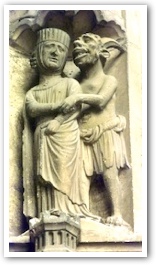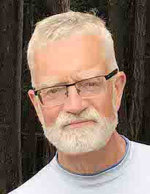Demonic Possession Involves Body, Not Soul
- FR. WILLIAM SAUNDERS
I went to see the movie, Exorcist III. I had already seen the first Exorcist. Can the devil really possess someone? Does the Church really do exorcisms?
 |
The devil and his demons can indeed possess an individual. The New Testament presents several stories of diabolical possession and our Lord's exorcism of the demons. For instance, Jesus exorcized the demons (who identify themselves as "legion") of Gerasa. The possessed man was so strong he was able to pull apart the chains that bound him and smash them. In the end, the demons entered the swine and destroyed them (Confer Mk 5:1-20). In each of the exorcism stories, we see Christ triumphantly vanquishing the devil and his demons.
Christ also empowered the Apostles to cast out demons in His name: "Then He summoned His twelve disciples and gave them authority to expel unclean spirits and to cure sickness and disease of every kind" (Mt 10:1). The practice of exorcism is recorded in the writings of the early Church Fathers, including St. Justin Martyr (d. 165), Tertullian (d. 230) and St. Cyril of Jerusalem (d. 386). Over the course of the centuries, the Church has well documented cases of possession and exorcism, including the one which was the basis of the original "Exorcist" movie (although neither Hollywood nor the book was faithful to the facts).
Given this brief Biblical and historical foundation, we can better examine the issue. Father Jordan Aumann, O.P., a noted professor of spiritual theology, offers the following definition: "Diabolical possession is a phenomenon in which the devil invades the body of a living person and moves the faculties and organs as if he were manipulating a body of his own. The devil truly resides within the body of the unfortunate victim, and he operates in it and treats it as his own property. Those who suffer this despotic invasion are said to be possessed" (Spiritual Theology, 408). However, the soul cannot be entered or overcome and thus remains free; in a sense, the soul really the person is like in a state of suspended animation. Pope Benedict XIV in his teaching "De servorum Dei beatificatione, et beatorum canonizatione" stated, "Demons, in the individuals whom they possess, are like motors within the bodies which they move, but in such a way that they impress no quality on the body nor do they give it any new mode of existence nor, strictly speaking, do they constitute, together with the possessed person, a single being."
In determining whether a person is possessed by the devil or his demons, the Church would first make sure he underwent thorough physical and psychiatric examinations. Eliminating these natural causes, Church officials would seek other signs: unexplainable physical phenomena, such as levitation or the uncaused movement of objects; displaying strength that surpasses one's condition; the knowledge and usage of archaic languages that the person would have no way of previously knowing, such as speaking Aramaic; and the secret knowledge of a person's life, particularly the exorcist, which no other person would know. Another sign is the vehement aversion to God, the Blessed Mother, the saints, the crucifix and sacred images, demonstrated by blasphemous remarks or sacrilegious actions. The devil also reveals his presence by acts of anger and violence, and through blasphemous, sacrilegious, profane and obscene remarks. The bishop would authorize an exorcism only after serious examination and a careful weighing of all of the evidence, and thereupon appoint a priest to perform the exorcism.
The Roman Ritual prescribes a Rite of Exorcism containing a series of prayers, blessings and invocations in the exorcizing of the devil. (The Sacred Congregation for Divine Worship and the Discipline of the Sacraments released a revised ritual on Jan. 26, 2000, with the approval of Pope John Paul II.) The holy arsenal of weapons used in an exorcism include sacramental confession, the reception of holy Communion, fasting and prayer (particularly saying the rosary), the use of sacramentals (like blessings with holy water, the presence of a crucifix or other religious images), blessings with the relics of saints and the invocation of the names of Jesus, the Blessed Virgin Mary and St. Michael. To underscore the point about sacramentals, St. Teresa of Avila in The Book of Her Life stated, "I often experience that there is nothing the devils flee from more -without returning than holy water" (Chapter 31); she taught that the devil cannot stand the name of Jesus, the crucifix and holy water. The exorcism ritual is repeated until the devil is cast out of the person, at which time the exorcist petitions God to never permit the devil to possess the person again.
During the course of the diabolical possession and even the exorcism, the person has not only periods of crisis when the struggle with evil is most apparent, but also periods of calm when one thinks the possession has ended. Interestingly, after the exorcism, the person does not remember what transpired while being possessed.
Why would God allow the devil to possess someone? We must remember that we all contend with the temptations of the prince of this world. After all, we are the weak victims of original sin and need God's grace to do what is holy and good. When the new ritual for exorcism was released, Cardinal Medina, then Prefect of the Congregation for Divine Worship and the Discipline of the Sacraments, stated very poignantly, " ... I would like to stress that the evil influence of the devil and his followers is usually exercised through deceit and confusion. Just as Jesus is the Truth, so the devil is the liar par excellence. He deceives human beings by making them believe that happiness is found in money, power or carnal desire. He deceives them into thinking that they do not need God, that grace and salvation are unnecessary. He even deceives them by diminishing the sense of sin or even suppressing it altogether, replacing God's law as the criterion of morality with the habits or conventions of the majority." Consequently, spiritual writers think that a person has some initial openness to such a possession, through, for example, living a mortally sinful lifestyle, the habitual practice of evil, the desire to explore the occult and the fascination with forms of spiritism, magic and sorcery. For example, in the actual story which served as the basis for "The Exorcist," the little boy, before he was possessed, participated in séances conducted by his aunt and began using the Ouija board.
Why would the devil want to possess a person? In the book The Exorcist, the older priest, Father Merrin, speaks with the young Father Karras, who asked him, "Why this girl? It makes no sense." Father Merrin, an experienced exorcist, replied, "I think the point is to make us despair to see ourselves as animal and ugly, to reject the possibility that God could love us." Although this text is fictional, that underlying message is valid. Whether through the horror of sin or possession, the devil wants to shatter our belief that God loves us beyond our imagining and will even forgive any sin if we are truly sorry. Instead, we must constantly turn to our Lord, and keep our eyes focused on Him. We must utilize the arsenal of graces He has entrusted to the Church, particularly the sacraments of penance and holy Eucharist, and the sacramentals, like the crucifix and holy water. Daily prayer is essential, including the recitation of the prayer to St. Michael the Archangel. Therefore, we have great hope, for our Lord is "the way, the truth and the life" (Jn 14:6) who has "overcome the world" (Jn 16:33). The love of our Lord will always conquer evil.
 This is J. Fraser Field, Founder of CERC. I hope you appreciated this piece. We curate these articles especially for believers like you.
This is J. Fraser Field, Founder of CERC. I hope you appreciated this piece. We curate these articles especially for believers like you.
Please show your appreciation by making a $3 donation. CERC is entirely reader supported.

Acknowledgement
Saunders, Rev. William. "Demonic Possession Involves Body, Not Soul." Arlington Catholic Herald.
This article is reprinted with permission from Arlington Catholic Herald.
The Author

 Father William Saunders is pastor of Our Lady of Hope parish in Potomac Falls, Virginia. He is dean of the Notre Dame Graduate School of Christendom College. The above article is a "Straight Answers" column he wrote for the Arlington Catholic Herald. Father Saunders is the author of Straight Answers, a book based on 100 of his columns, and Straight Answers II.
Father William Saunders is pastor of Our Lady of Hope parish in Potomac Falls, Virginia. He is dean of the Notre Dame Graduate School of Christendom College. The above article is a "Straight Answers" column he wrote for the Arlington Catholic Herald. Father Saunders is the author of Straight Answers, a book based on 100 of his columns, and Straight Answers II.


